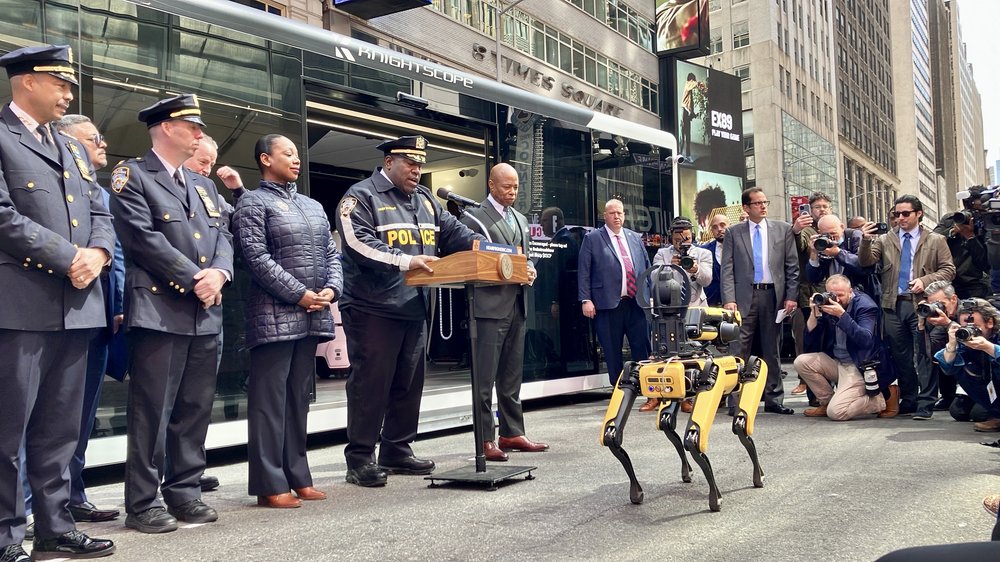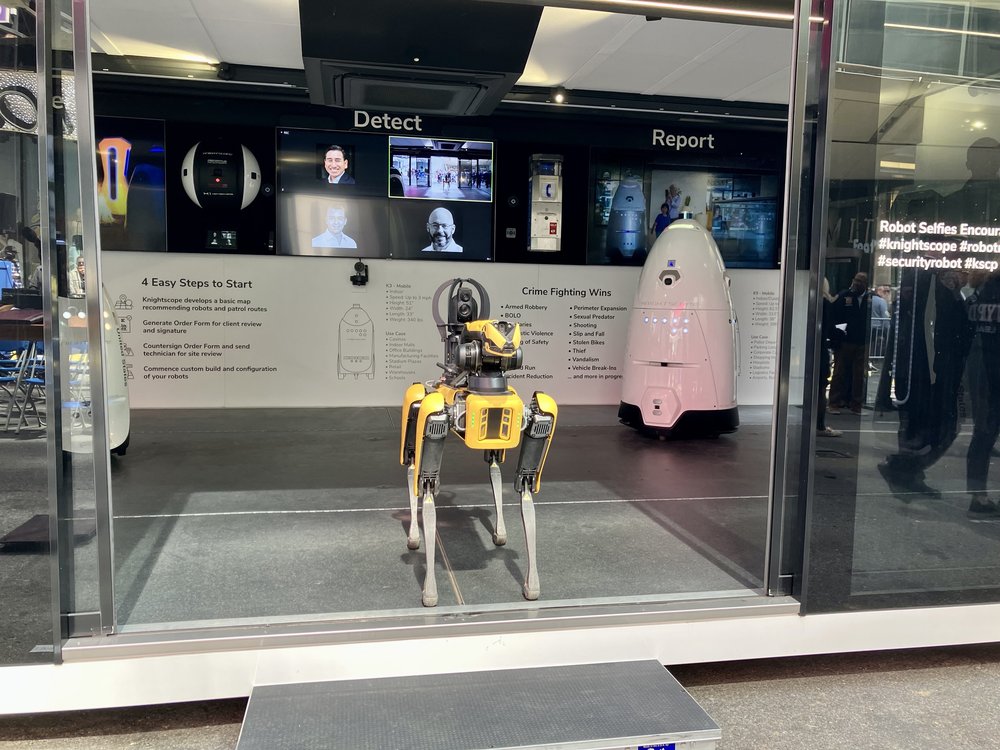Robot dogs, tiny rocket ships will soon work alongside NYPD officers
April 11, 2023, 3:31 p.m.
The pilot program announced by Mayor Eric Adams will test out the robots before the city commits to purchasing any.

Robots descended on Times Square on Tuesday morning.
However, there was no apocalyptic alien invasion taking place, and no dystopian movies were being filmed. Rather, the NYPD was showing off three devices it is using to work alongside human officers during a press conference with Mayor Eric Adams and police officials.
One device, from the company StarChase, will allow police to shoot a projectile that attaches a GPS device onto cars to track their movements remotely. Police said the goal is to avoid high-speed vehicle pursuits, so officers can locate cars without chasing after them.
The department is also testing a device called the K5 Autonomous Security Robot — a white robot on wheels that looks like a cross between a tiny rocket ship and R2-D2 — which will be used to patrol small areas, like subway stations or Times Square.
NYPD Chief of Department Jeffrey Maddrey said the K5 “uses artificial intelligence to provide real-time communications to first responders.” Knightscope, which manufactures the robot, reports that it has been deployed to 30 clients in 10 states, including at malls and hospitals.
The K5 has been in some sticky situations in other cities. One of the robots was toppled and slathered in barbecue sauce in San Francisco, and another was beat up by an intoxicated man in Mountain View, California, according to news reports. Another robot fell into a pool of water outside an office building in Washington, D.C.
Our D.C. office building got a security robot. It drowned itself.
— Bilal Farooqui (@bilalfarooqui) July 17, 2017
We were promised flying cars, instead we got suicidal robots. pic.twitter.com/rGLTAWZMjn
The NYPD is leasing the StarChase and K5 devices for now and declined to share how much it is spending on pilot programs to test out the robots before it decides whether to buy them.
Perhaps the most controversial technology displayed on Tuesday was Spot the Digidog, a K9-like remote-controlled robot that police said can be used to assess dangerous situations like hostage negotiations, terrorism incidents and encounters with people in mental health crises.
The department began using the technology in 2020, but ended its contract with the company that makes the Digidog in the spring of 2021, after a video of the robot running through a public housing complex in Manhattan went viral. Police reform advocates and lawmakers raised concerns about the technology’s cost and potential privacy violations.
Digidog makes an appearance. NYPD says the department spent $750k of forfeiture money to purchase the technology. Maddrey says it will only be used at his orders. pic.twitter.com/krxNjMcYfv
— Samantha Max (@samanthaellimax) April 11, 2023
But Adams said he was confident that the device would work better this time, because he’s more of a “computer geek” than his predecessor.
“Digidog is out of the pound,” he said. “Digidog is now part of the tool kit that we are using.”
Maddrey said the device will only be controlled by trained officers in the Technical Assistance and Response Unit and will be used in operations with the Emergency Service Unit. He added that the Digidog will only be deployed upon his orders.
The department said it spent $750,000 of forfeiture money to purchase two Digidogs, meaning the funding came from dollars seized following an arrest instead of from the NYPD’s capital budget. When asked if the NYPD ought to be spending that much money on robots in light of Adams' announcement last week that he’s asking most city agencies to cut 4% of their budgets, the mayor defended the purchase.
“There is never the wrong time for public safety,” he said. “This is not paying and wasting. This is an investment in our public safety.”
Adams said Tuesday’s demonstration would be the first in a series of technology rollouts. But City Hall’s push to equip the NYPD with state-of-the-art robots is raising alarms among police reform advocates, who have privacy and budget concerns.
“I promise that if there is a series of new technologies, there’s going to be a series of new lawsuits,” said Albert Fox Cahn, the executive director of the Surveillance Technology Oversight Project. “The mayor doesn’t get to rewrite the Constitution simply because it’s inconvenient.”

Cahn said he’s skeptical that the devices actually work. He said sending a robot dog to a call with someone in the midst of a mental health crisis would be “ludicrous” and doubted that it would help to de-escalate the situation. Artificial intelligence can also be biased against certain groups or make mistakes, he added.
Cahn wants more transparency about how the devices work.
In 2020, the City Council passed the POST Act, which requires the NYPD to publish policies on all of its surveillance technologies and to incorporate feedback from the public into those guidelines. The Office of the Inspector General for the NYPD published a report last fall that found the department has been using “vague, non-specific boilerplate language” to skirt the law and limit the amount of information it’s sharing. The NYPD said at the time that it had complied with the law’s requirements.
Other advocates have also been quick to condemn the rollout of the new technology.
“Mayor Adams continues to pour money into the NYPD’s bloated budget, enabling police to impose new, dystopian surveillance technologies throughout the city without meaningfully engaging New Yorkers in a conversation about whether this is how we want to live,” said Redmond Haskins, a spokesperson for the Legal Aid Society, in a statement.
Preacher Loc Amadeus and Tyrone Pinckney, two friends from the Bronx, said they were concerned when they walked past the demonstration in Times Square, citing concerns about the devices invading people’s privacy. They said they'd rather see the city spend money on resources to address homelessness or raise workers’ wages.
Amadeus, who is Black, also said sending robots into neighborhoods could further erode trust between police and people of color.
“It’s hard to get people to express humanity on both sides — be it the police or my community,” he said. “So, to think that a robot is going to express humanity is really crazy. Which is why I don’t like it.”